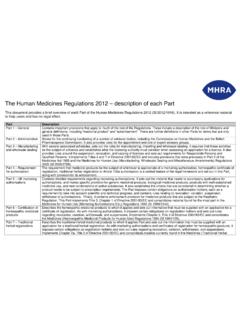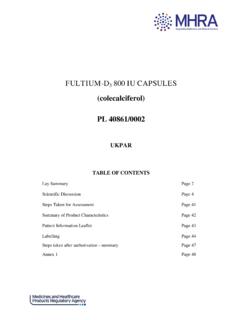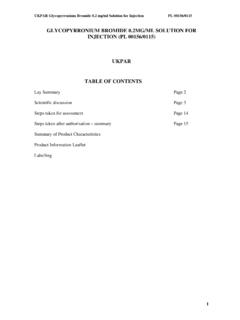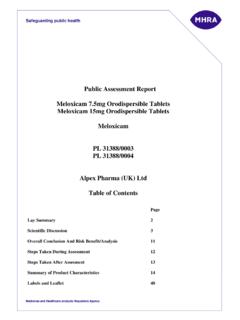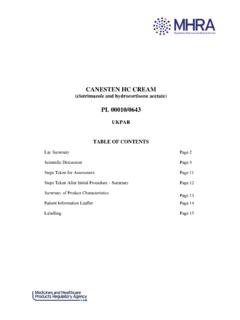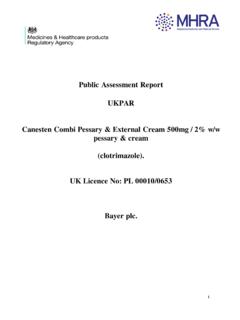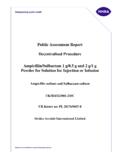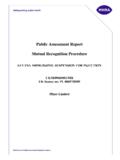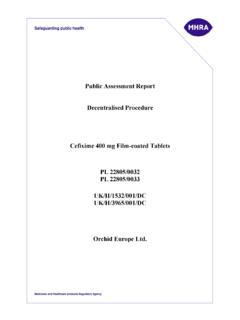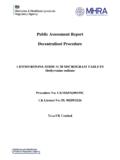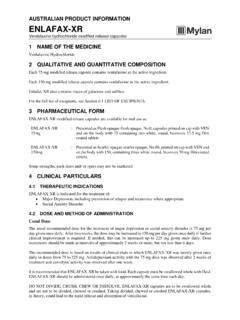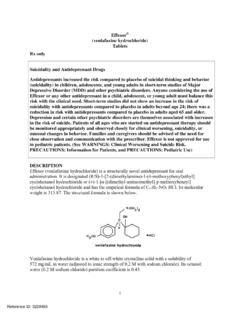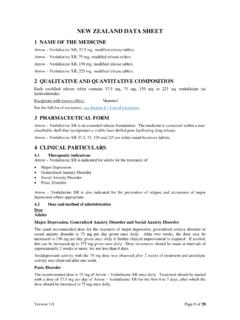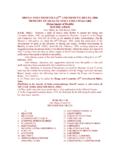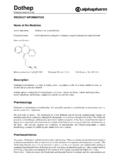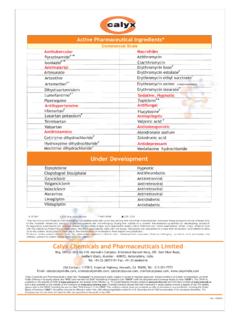Transcription of Public Assessment Report Decentralised Procedure - GOV.UK
1 PAR Propafenone hydrochloride 150mg and 300mg Film-coated Tablets PL 20620/0034-5; UK/H/1208/01-02/DC 1 Public Assessment Report Decentralised Procedure Propafenone hydrochloride 150mg Film-coated Tablets Propafenone hydrochloride 300mg Film-coated Tablets (propafenone hydrochloride ) UK/H/1208/01-02/DC UK licence numbers: PL 20620/0034-5 NRIM Limited PAR Propafenone hydrochloride 150mg and 300mg Film-coated Tablets PL 20620/0034-5; UK/H/1208/01-02/DC 2 LAY SUMMARY On 24th December 2010, the MHRA granted NRIM Limited Marketing Authorisations (licences) for the medicinal products Propafenone hydrochloride 150mg Film-coated Tablets and Propafenone hydrochloride 300mg Film-coated Tablets (PL 20620/0034-5). These are prescription-only medicines (POM). Propafenone is one of a group of medicines called anti-arrhythmic agents and is used for the following: To slow down the heart rate and help to regulate the heartbeat To treat and prevent arrhythmias (abnormal heart rhythms) The test products were considered to be generic versions of the reference products Arythmol 150mg and 300mg tablets (PL 00037/0331 and 0332, Abbott Laboratories Limited) based on the data submitted by NRIM Limited.
2 No new or unexpected safety concerns arose from these applications and it was, therefore, judged that the benefits of Propafenone hydrochloride 150mg and 300mg Film-coated Tablets outweigh the risks; hence Marketing Authorisations have been granted. PAR Propafenone hydrochloride 150mg and 300mg Film-coated Tablets PL 20620/0034-5; UK/H/1208/01-02/DC 3 TABLE OF CONTENTS Module 1: Information about initial Procedure Page 4 Module 2: Summary of Product Characteristics Page 5 Module 3: Product Information Leaflet Page 12 Module 4: Labelling Page 14 Module 5: Scientific discussion during initial Procedure Page 18 I Introduction Page 18 II About the product Page 20 III Scientific Overview and discussion Page 21 Quality aspects Page 21 Non-clinical aspects Page 24
3 Clinical aspects Page 24 IV Overall conclusions and benefit-risk Assessment Page 29 Module 6: Steps taken after initial Procedure Page 30 PAR Propafenone hydrochloride 150mg and 300mg Film-coated Tablets PL 20620/0034-5; UK/H/1208/01-02/DC 4 Module 1 Information about Initial Procedure Product Name Propafenone hydrochloride 150mg Film-coated Tablets Propafenone hydrochloride 300mg Film-coated Tablets Type of Application Generic, Article Active Substance Propafenone hydrochloride Form Film-coated tablets Strength 150 mg, 300 mg MA Holder NRIM Limited Marlborough House 298, Regents Park Road Finchley N3 2UA London, United Kingdom Reference Member State (RMS) UK Concerned Member States (CMS) UK/H/1208/01-02/DC: Belgium, Germany, Ireland, The Netherlands Procedure Number UK/H/1208/01-02/DC Timetable End of Procedure : Day 210 8th December 2010 PAR Propafenone hydrochloride 150mg and 300mg Film-coated Tablets PL 20620/0034-5.
4 UK/H/1208/01-02/DC 5 Module 2 Summary of Product Characteristics The UK Summary of Product Characteristics (SmPC) for Propafenone hydrochloride 150mg and 300mg Film-coated Tablets (PL 20620/0034-5) is as follows. Differences between the individual SmPCs are highlighted: 1 NAME OF THE MEDICINAL PRODUCT Propafenone hydrochloride 150mg Film-coated Tablets Propafenone hydrochloride 300mg Film-coated Tablets 2 QUALITATIVE AND QUANTITATIVE COMPOSITION Each film-coated tablet contains 150mg / 300mg propafenone hydrochloride For a full list of excipients, see section 3 PHARMACEUTICAL FORM Film-coated Tablet For 150mg strength tablets: White to off white, round shaped, biconvex, film coated tablets plain on both sides. For 300mg strength tablets: White to off-white, round, biconvex, film-coated tablets, with score line on one side and plain on the other side.
5 The tablet can be divided in to equal halves. 4 CLINICAL PARTICULARS Therapeutic indications Propafenone is indicated for the prophylaxis and treatment of ventricular arrhythmias. Propafenone is also indicated for the prophylaxis and treatment of paroxysmal supraventricular tachyarrhythmias which include paroxysmal atrial flutter/fibrillation and paroxysmal re-entrant tachycardia s involving the AV node or accessory bypass tracts, when standard therapy has failed or is contraindicated. Posology and method of administration It is recommended that Propafenone therapy should be initiated under hospital conditions, by a physician experienced in the treatment of arrhythmias. The individual maintenance dose should be determined under cardiological surveillance including ECG monitoring and blood pressure control.
6 If the QRS interval is prolonged by more than 160msec or the PQ interval is prolonged by more than 20%, the dose should be reduced or discontinued until the ECG returns to normal limits. Adults Initially, 150 mg three times daily increasing at a minimum of three-day intervals to 300 mg twice daily and if necessary, to a maximum of 300 mg three times daily. The tablets should be swallowed whole and taken with a drink after food. A reduction in the total daily dose is recommended for patients below 70 kg bodyweight. The recommended dose is to 5-12mg/kg/day. Elderly Higher plasma concentrations of propafenone have been noted during treatment. Elderly patients may therefore respond to a lower dose. In addition treatment in elderly patients or patients with relevant impairment of ventricular function (left ventricular ejection fraction less than 35%) or structural myocardial disease, should be initiated gradually and with particular caution in small incremental doses.
7 The same applies to maintenance therapy. Any dose increases that may be required should not be undertaken until after five to eight days of therapy. PAR Propafenone hydrochloride 150mg and 300mg Film-coated Tablets PL 20620/0034-5; UK/H/1208/01-02/DC 6 Children A suitable dosage form of propafenone hydrochloride tablets for children is not available. Dosage in impaired liver function Propafenone is extensively metabolised via a saturable hepatic oxidase pathway. In view of the increased bioavailability and elimination half-life of propafenone, a reduction in the recommended dose may be necessary. Dosage in impaired renal function Although the elimination of propafenone and its major metabolite is not affected by renal impairment, propafenone should be administered cautiously. Contraindications Propafenone is contra-indicated in patients with Known hypersensitivity to propafenone or to any of the other ingredients.
8 Uncontrolled congestive heart failure where left ventricular output is less than 35%, cardiogenic shock (unless arrhythmia-induced), severe bradycardia, uncontrolled electrolyte disturbances ( hyperkalemia or other potassium metabolism disorders), severe obstructive pulmonary disease or marked hypotension. Myasthenia gravis. Myocardial infarction in the previous 3 months unless life threatening ventricular arryhtmias. Unless patients are adequately paced (see section , Special Warnings and Precautions for Use), Propafenone should not be used in the presence of sinus node dysfunction, atrial conduction defects, second degree or greater AV block, bundle branch block or distal block in the absence of an artificial pacemaker. Minor prolongation of the PR interval and intra-ventricular conduction defects (QRS duration of less than 20%) are to be expected during treatment with propafenone and do not warrant dose reduction or drug withdrawal.
9 Special warnings and precautions for use Electrolyte disturbances should first be treated before treatment with propafenone. The weak negative inotropic effect of propafenone may assume importance in patients predisposed to cardiac failure. In common with other anti-arrhythmic drugs, propafenone has been shown to alter sensitivity and pacing threshold. In patients with pacemakers, appropriate adjustments may be required. Because of the beta-blocking effect, care should be exercised in the treatment of patients with obstructive airways disease or asthma. Patients with structural heart disease may be predisposed to serious adverse effects. There is a risk of pro-arrhythmic effects, as with other anti-arrhythmics. Worsening of the ventricular arrhythmias is possible. For the treatment of ventricular arrhythmias, the patient should be under cardiological surveillance including ECG monitoring and blood pressure control and defribillator facilities should be available.
10 Treatment stop should be considered with one of the following ECG-changes: QRS or QT-interval prolongation with more than 25%, PR-interval prolongation with more than 50%, QT-interval prolongation with more than 500 msec, or a increase in numbers or worsening of the arrhythmias It is essential that each patient given propafenone hydrochloride be evaluated electrocardiographically and clinically prior to and during therapy to determine whether the response to propafenone hydrochloride supports continued treatment. There is potential for conversion of paroxysmal atrial fibrillation to atrial flutter with accompanying 2:1 or 1:1 conduction block. As with other class 1C anti-arrhythmic agents, patients with significant structural heart disease may be predisposed to serious adverse effects PAR Propafenone hydrochloride 150mg and 300mg Film-coated Tablets PL 20620/0034-5; UK/H/1208/01-02/DC 7 Interaction with other medicinal products and other forms of interaction The effects of propafenone may be potentiated if it is given in combination with other local anaesthetic type agents ( pacemaker implantation, surgery or dental work) or agents which depress myocardial activity ( beta blockers, tricyclic antidepressants).
